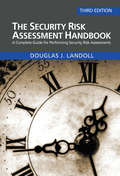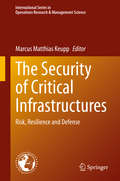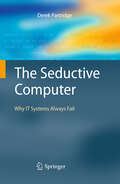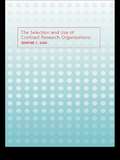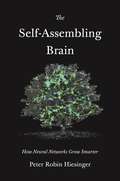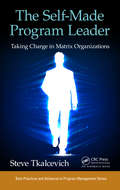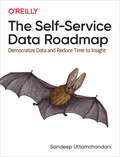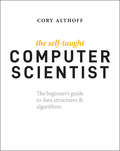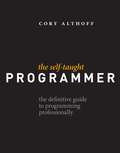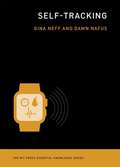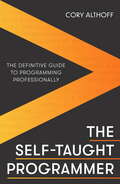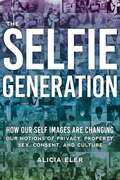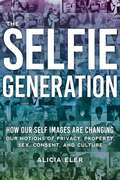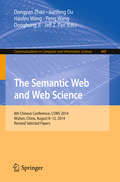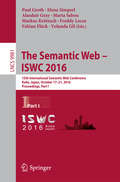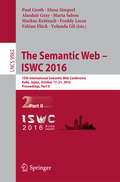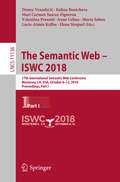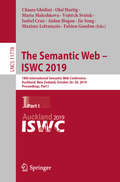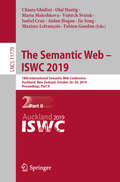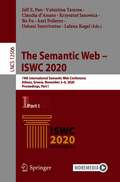- Table View
- List View
The Security Risk Assessment Handbook: A Complete Guide for Performing Security Risk Assessments
by Douglas LandollConducted properly, information security risk assessments provide managers with the feedback needed to manage risk through the understanding of threats to corporate assets, determination of current control vulnerabilities, and appropriate safeguards selection. Performed incorrectly, they can provide the false sense of security that allows potential threats to develop into disastrous losses of proprietary information, capital, and corporate value. Picking up where its bestselling predecessors left off, The Security Risk Assessment Handbook: A Complete Guide for Performing Security Risk Assessments, Third Edition gives you detailed instruction on how to conduct a security risk assessment effectively and efficiently, supplying wide-ranging coverage that includes security risk analysis, mitigation, and risk assessment reporting. The third edition has expanded coverage of essential topics, such as threat analysis, data gathering, risk analysis, and risk assessment methods, and added coverage of new topics essential for current assessment projects (e.g., cloud security, supply chain management, and security risk assessment methods). This handbook walks you through the process of conducting an effective security assessment, and it provides the tools, methods, and up-to-date understanding you need to select the security measures best suited to your organization. Trusted to assess security for small companies, leading organizations, and government agencies, including the CIA, NSA, and NATO, Douglas J. Landoll unveils the little-known tips, tricks, and techniques used by savvy security professionals in the field. It includes features on how to Better negotiate the scope and rigor of security assessments Effectively interface with security assessment teams Gain an improved understanding of final report recommendations Deliver insightful comments on draft reports This edition includes detailed guidance on gathering data and analyzes over 200 administrative, technical, and physical controls using the RIIOT data gathering method; introduces the RIIOT FRAME (risk assessment method), including hundreds of tables, over 70 new diagrams and figures, and over 80 exercises; and provides a detailed analysis of many of the popular security risk assessment methods in use today. The companion website (infosecurityrisk.com) provides downloads for checklists, spreadsheets, figures, and tools.
The Security of Critical Infrastructures: Risk, Resilience and Defense (International Series in Operations Research & Management Science #288)
by Marcus Matthias KeuppThis book analyzes the security of critical infrastructures such as road, rail, water, health, and electricity networks that are vital for a nation’s society and economy, and assesses the resilience of these networks to intentional attacks. The book combines the analytical capabilities of experts in operations research and management, economics, risk analysis, and defense management, and presents graph theoretical analysis, advanced statistics, and applied modeling methods. In many chapters, the authors provide reproducible code that is available from the publisher’s website. Lastly, the book identifies and discusses implications for risk assessment, policy, and insurability. The insights it offers are globally applicable, and not limited to particular locations, countries or contexts. Researchers, intelligence analysts, homeland security staff, and professionals who operate critical infrastructures will greatly benefit from the methods, models and findings presented. While each of the twelve chapters is self-contained, taken together they provide a sound basis for informed decision-making and more effective operations, policy, and defense.
The Seductive Computer
by Derek PartridgeIT systems explode budget estimates, bust production deadlines by years, and then fail to work properly. Why this IT-system crisis? Poor programmers? Inadequate project management? No. The Seductive Computer argues that the fundamental nature of programming technology itself is the real culprit; it promises perfection but can only deliver emergent chaos. It is also an insidiously compelling technology, peculiarly male oriented. IT systems, an unavoidable and increasing reality in all our lives, are something new to man - large-scale discrete complexity. The Seductive Computer explains this novelty that defies human understanding. This book illustrates in a simple yet thorough manner the underlying concepts necessary for understanding the IT-system crisis - not 'How To Program' but what the demands of programming are. It then proceeds to lay out the full gamut of issues - all stemming from the nature of the technology. From development to maintenance IT-system personnel are grappling with incipient chaos. The technicians are seduced by the detailed challenge of the technology. The scientists are seduced by the promises of their technology. The managers and users are seduced by the mysteries of the technology. No IT system is ever fully understood by anyone, so surprising behaviours will always emerge. What can be done? We must rein in our expectations of IT systems: what they can do, and how reliably they can do it. On the positive side, The Seductive Computer discusses novel paradigms that look beyond the current discrete technology: neural computing and precise approximation computing.
The Sega Mega Drive & Genesis Encyclopedia: Every Game Released for Sega's 16-bit Console
by Chris Scullion“An exhaustive, tremendous look back at one of the most beloved consoles of all time . . . an absolutely barnstorming recollection of a wonderful era.” —Finger GunsThe third book in Chris Scullion’s series of video game encyclopedias, The Sega Mega Drive and Genesis Encyclopedia is dedicated to Sega’s legendary 16-bit video game console. The book contains detailed information on every single game released for the Sega Mega Drive and Genesis in the west, as well as similarly thorough bonus sections covering every game released for its add-ons, the Mega CD and 32X. With nearly a thousand screenshots, generous helpings of bonus trivia and charmingly bad jokes, The Sega Mega Drive and Genesis Encyclopedia is the definitive guide to a legendary gaming system.“The Sega Mega Drive and Genesis Encyclopedia is a must-buy for fans of the console and a perfect addition to any retro game fan’s library.” —Goomba Stomp Magazine
The Selection and Use of Contract Research Organizations: A Guide For The Pharmaceutical And Medical Device Industries
by Shayne C. GadChoosing the right contract research organization (CRO) can make the difference between getting a product to market quickly and cost-effectively, and wasting valuable time and money. The vast number of available CROs is increasing all the time, and all of them make impressive claims. The Selection and Use of Contract Research Organizations is your
The Self-Assembling Brain: How Neural Networks Grow Smarter
by Peter Robin HiesingerWhat neurobiology and artificial intelligence tell us about how the brain builds itself How does a neural network become a brain? While neurobiologists investigate how nature accomplishes this feat, computer scientists interested in artificial intelligence strive to achieve this through technology. The Self-Assembling Brain tells the stories of both fields, exploring the historical and modern approaches taken by the scientists pursuing answers to the quandary: What information is necessary to make an intelligent neural network?As Peter Robin Hiesinger argues, “the information problem” underlies both fields, motivating the questions driving forward the frontiers of research. How does genetic information unfold during the years-long process of human brain development—and is there a quicker path to creating human-level artificial intelligence? Is the biological brain just messy hardware, which scientists can improve upon by running learning algorithms on computers? Can AI bypass the evolutionary programming of “grown” networks? Through a series of fictional discussions between researchers across disciplines, complemented by in-depth seminars, Hiesinger explores these tightly linked questions, highlighting the challenges facing scientists, their different disciplinary perspectives and approaches, as well as the common ground shared by those interested in the development of biological brains and AI systems. In the end, Hiesinger contends that the information content of biological and artificial neural networks must unfold in an algorithmic process requiring time and energy. There is no genome and no blueprint that depicts the final product. The self-assembling brain knows no shortcuts.Written for readers interested in advances in neuroscience and artificial intelligence, The Self-Assembling Brain looks at how neural networks grow smarter.
The Self-Made Program Leader: Taking Charge in Matrix Organizations (Best Practices in Portfolio, Program, and Project Management #21)
by Steve TkalcevichAlmost all leadership books assume that the leader has authority over their team members. The challenge of project management in a matrix-structured environment is that this is not always the case. A whole new plan of attack has to be executed for the project manager to deliver in an organization where they do not have formal authority. This book t
The Self-Service Data Roadmap: Democratize Data And Reduce Time To Insight
by Sandeep UttamchandaniData-driven insights are a key competitive advantage for any industry today, but deriving insights from raw data can still take days or weeks. Most organizations can’t scale data science teams fast enough to keep up with the growing amounts of data to transform. What’s the answer? Self-service data.With this practical book, data engineers, data scientists, and team managers will learn how to build a self-service data science platform that helps anyone in your organization extract insights from data. Sandeep Uttamchandani provides a scorecard to track and address bottlenecks that slow down time to insight across data discovery, transformation, processing, and production. This book bridges the gap between data scientists bottlenecked by engineering realities and data engineers unclear about ways to make self-service work.Build a self-service portal to support data discovery, quality, lineage, and governanceSelect the best approach for each self-service capability using open source cloud technologiesTailor self-service for the people, processes, and technology maturity of your data platformImplement capabilities to democratize data and reduce time to insightScale your self-service portal to support a large number of users within your organization
The Self-Taught Computer Scientist: The Beginner's Guide to Data Structures & Algorithms
by Cory AlthoffThe Self-Taught Computer Scientist is Cory Althoff's follow-up to The Self-Taught Programmer, which inspired hundreds of thousands of professionals to learn how to program outside of school. In The Self-Taught Programmer, Cory showed readers why you don't need a computer science degree to program professionally and taught the programming fundamentals he used to go from a complete beginner to a software engineer at eBay without one. In The Self-Taught Computer Scientist, Cory teaches you the computer science concepts that all self-taught programmers should understand to have outstanding careers. The Self-Taught Computer Scientist will not only make you a better programmer; it will also help you pass your technical interview: the interview all programmers have to pass to land a new job. Whether you are preparing to apply for jobs or sharpen your computer science knowledge, reading The Self-Taught Computer Scientist will improve your programming career. It's written for complete beginners, so you should have no problem reading it even if you've never studied computer science before.
The Self-Taught Programmer: The Definitive Guide to Programming Professionally, 1st Edition
by Cory AlthoffI am a self-taught programmer. After a year of self-study, I learned to program well enough to land a job as a software engineer II at eBay. Once I got there, I realized I was severely under-prepared. I was overwhelmed by the amount of things I needed to know but hadn't learned yet. My journey learning to program, and my experience at my first job as a software engineer were the inspiration for this book. <P><P>This book is not just about learning to program; although you will learn to code. If you want to program professionally, it is not enough to learn to code; that is why, in addition to helping you learn to program, I also cover the rest of the things you need to know to program professionally that classes and books don't teach you. "The Self-taught Programmer" is a roadmap, a guide to take you from writing your first Python program, to passing your first technical interview. I divided the book into five sections: <P><P> 1. Learn to program in Python 3 and build your first program. </br> 2. Learn Object-oriented programming and create a powerful Python program to get you hooked. </br> 3. Learn to use tools like Git, Bash, regular expressions and databases. Then use your new coding skills to build a web scraper. </br> 4. Study Computer Science fundamentals like data structures and algorithms.</br> 5. Finish with tips for working with a team and landing a programming job. <P><P>You CAN learn to program professionally. The path is there. Will you take it?
The Self-Tracking
by Gina Neff Dawn NafusPeople keep track. In the eighteenth century, Benjamin Franklin kept charts of time spent and virtues lived up to. Today, people use technology to self-track: hours slept, steps taken, calories consumed, medications administered. Ninety million wearable sensors were shipped in 2014 to help us gather data about our lives. This book examines how people record, analyze, and reflect on this data, looking at the tools they use and the communities they become part of. Gina Neff and Dawn Nafus describe what happens when people turn their everyday experience -- in particular, health and wellness-related experience -- into data, and offer an introduction to the essential ideas and key challenges of using these technologies. They consider self-tracking as a social and cultural phenomenon, describing not only the use of data as a kind of mirror of the self but also how this enables people to connect to, and learn from, others.Neff and Nafus consider what's at stake: who wants our data and why; the practices of serious self-tracking enthusiasts; the design of commercial self-tracking technology; and how self-tracking can fill gaps in the healthcare system. Today, no one can lead an entirely untracked life. Neff and Nafus show us how to use data in a way that empowers and educates.
The Self-taught Programmer: The Definitive Guide to Programming Professionally
by Cory Althoff'One of the best software design books of all time' - BookAuthorityCory Althoff is a self-taught programmer. After a year of self-study, he learned to program well enough to land a job as a software engineer II at eBay. But once he got there, he realised he was severely under-prepared. He was overwhelmed by the amount of things he needed to know but hadn't learned. His journey learning to program, and his experience in first software engineering job were the inspiration for this book. This book is not just about learning to program, although you will learn to code. If you want to program professionally, it is not enough to learn to code; that is why, in addition to helping you learn to program, Althoff also cover the rest of the things you need to know to program professionally that classes and books don't teach you. The Self-taught Programmer is a roadmap, a guide to take you from writing your first Python program to passing your first technical interview. The book is divided into five sections: 1. Learn to program in Python 3 and build your first program. 2. Learn object-oriented programming and create a powerful Python program to get you hooked. 3. Learn to use tools like Git, Bash and regular expressions. Then use your new coding skills to build a web scraper. 4. Study computer science fundamentals like data structures and algorithms. 5. Finish with best coding practices, tips for working with a team and advice on landing a programming job.You can learn to program professionally. The path is there. Will you take it?From the authorI spent one year writing The Self-Taught Programmer. It was an exciting and rewarding experience. I treated my book like a software project. After I finished writing it, I created a program to pick out all of the code examples from the book and execute them in Python to make sure all 300+ examples worked properly. Then I wrote software to add line numbers and color to every code example. Finally, I had a group of 200 new programmers 'beta read' the book to identify poorly explained concepts and look for any errors my program missed. I hope you learn as much reading my book as I did writing it. Best of luck with your programming!
The Selfie Generation: How Our Self-Images Are Changing Our Notions of Privacy, Sex, Consent, and Culture
by Alicia ElerWhether it's Kim Kardashian uploading picture after picture to Instagram or your roommate posting a mid-vacation shot to Facebook, selfies receive mixed reactions. But are selfies more than, as many critics lament, a symptom of a self-absorbed generation? Millennial Alicia Eler's The Selfie Generation is the first book to delve fully into this ubiquitous and much-maligned part of social media, including why people take them in the first place and the ways they can change how we see ourselves. Eler argues that selfies are just one facet of how we can use digital media to create a personal brand in the modern age. More than just a picture, they are an important part of how we live today. Eler examines all aspects of selfies, online social networks, and the generation that has grown up with them. She looks at how the boundaries between people’s physical and digital lives have blurred with social media; she explores questions of privacy, consent, ownership, and authenticity; and she points out important issues of sexism and double standards wherein women are encouraged to take them but then become subject to criticism and judgment. Alicia discusses the selfie as a paradox-both an image with potential for self-empowerment, yet also a symbol of complacency within surveillance culture The Selfie Generation explores just how much social media has changed the ways that people connect, communicate, and present themselves to the world.
The Selfie Generation: How Our Self-Images Are Changing Our Notions of Privacy, Sex, Consent, and Culture
by Alicia Eler<p>Whether it's Kim Kardashian uploading picture after picture to Instagram or your roommate posting a mid-vacation shot to Facebook, selfies receive mixed reactions. But are selfies more than, as many critics lament, a symptom of a self-absorbed generation? <p>Millennial Alicia Eler's The Selfie Generation is the first book to delve fully into this ubiquitous and much-maligned part of social media, including why people take them in the first place and the ways they can change how we see ourselves. Eler argues that selfies are just one facet of how we can use digital media to create a personal brand in the modern age. More than just a picture, they are an important part of how we live today. <p>Eler examines all aspects of selfies, online social networks, and the generation that has grown up with them. She looks at how the boundaries between people’s physical and digital lives have blurred with social media; she explores questions of privacy, consent, ownership, and authenticity; and she points out important issues of sexism and double standards wherein women are encouraged to take them but then become subject to criticism and judgment. Alicia discusses the selfie as a paradox—both an image with potential for self-empowerment, yet also a symbol of complacency within surveillance culture The Selfie Generation explores just how much social media has changed the ways that people connect, communicate, and present themselves to the world.</p>
The Semantic Web Explained
by Peter Szeredi Gergely Lukacsy Tamas BenkoThe Semantic Web is a new area of research and development in the field of computer science that aims to make it easier for computers to process the huge amount of information on the web, and indeed other large databases, by enabling them not only to read, but also to understand the information. Based on successful courses taught by the authors, and liberally sprinkled with examples and exercises, this comprehensive textbook describes not only the theoretical issues underlying the Semantic Web, but also algorithms, optimisation ideas and implementation details. The book will therefore be valuable to practitioners as well as students, indeed to anyone who is interested in Internet technology, knowledge engineering or description logics. Supplementary materials available online include the source code of program examples and solutions to selected exercises.
The Semantic Web and Web Science
by Jeff Z. Pan Dongyan Zhao Jianfeng Du Haofen Wang Peng Wang Donghong JiThis book constitutes the thoroughly refereed papers of the 8th Chinese Conference on The Semantic Web and Web Science, CSWS 2014, held in Wuhan, China, in August 2014. The 22 research papers presented were carefully reviewed and selected from 61 submissions. The papers are organized in topical sections such as ontology reasoning and learning; semantic data generation and management; and semantic technology and applications.
The Semantic Web – ISWC 2016
by Paul Groth Alasdair Gray Elena Simperl Marta Sabou Markus Krötzsch Freddy Lecue Fabian Flöck Yolanda GilThe two-volume set LNCS 9981 and 9982 constitutes the refereed proceedings of the 15th International Semantic Web Conference, ISWC 2016, which was held in Kobe, Japan, in October 2016. The 75 full papers presented in these proceedings were carefully reviewed and selected from 326 submissions. The International Semantic Web Conference is the premier forum for Semantic Web research, where cutting edge scientific results and technological innovations are presented, where problems and solutions are discussed, and where the future of this vision is being developed. It brings together specialists in fields such as artificial intelligence, databases, social networks, distributed computing, Web engineering, information systems, human-computer interaction, natural language processing, and the social sciences. The Research Track solicited novel and significant research contributions addressing theoretical, analytical, empirical, and practical aspects of the Semantic Web. The Applications Track solicited submissions exploring the benefits and challenges of applying semantic technologies in concrete, practical applications, in contexts ranging from industry to government and science. The newly introduced Resources Track sought submissions providing a concise and clear description of a resource and its (expected) usage. Traditional resources include ontologies, vocabularies, datasets, benchmarks and replication studies, services and software. Besides more established types of resources, the track solicited submissions of new types of resources such as ontology design patterns, crowdsourcing task designs, workflows, methodologies, and protocols and measures.
The Semantic Web – ISWC 2016
by Paul Groth Alasdair Gray Elena Simperl Marta Sabou Markus Krötzsch Freddy Lecue Fabian Flöck Yolanda GilThe two-volume set LNCS 9981 and 9982 constitutes the refereed proceedings of the 15th International Semantic Web Conference, ISWC 2016, which was held in Kobe, Japan, in October 2016. The 75 full papers presented in these proceedings were carefully reviewed and selected from 326 submissions. The International Semantic Web Conference is the premier forum for Semantic Web research, where cutting edge scientific results and technological innovations are presented, where problems and solutions are discussed, and where the future of this vision is being developed. It brings together specialists in fields such as artificial intelligence, databases, social networks, distributed computing, Web engineering, information systems, human-computer interaction, natural language processing, and the social sciences. The Research Track solicited novel and significant research contributions addressing theoretical, analytical, empirical, and practical aspects of the Semantic Web. The Applications Track solicited submissions exploring the benefits and challenges of applying semantic technologies in concrete, practical applications, in contexts ranging from industry to government and science. The newly introduced Resources Track sought submissions providing a concise and clear description of a resource and its (expected) usage. Traditional resources include ontologies, vocabularies, datasets, benchmarks and replication studies, services and software. Besides more established types of resources, the track solicited submissions of new types of resources such as ontology design patterns, crowdsourcing task designs, workflows, methodologies, and protocols and measures.
The Semantic Web – ISWC 2018: 17th International Semantic Web Conference, Monterey, CA, USA, October 8–12, 2018, Proceedings, Part I (Lecture Notes in Computer Science #11136)
by Valentina Presutti Elena Simperl Mari Carmen Suárez-Figueroa Marta Sabou Denny Vrandečić Kalina Bontcheva Irene Celino Lucie-Aimée KaffeeThe two-volume set LNCS 11136 and 11137 constitutes the refereed proceedings of the 17th International Semantic Web Conference, ISWC 2018, held in Monterey, USA, in October 2018. The ISWC conference is the premier international forum for the Semantic Web / Linked Data Community. The total of 62 full papers included in this volume was selected from 250 submissions. The conference is organized in three tracks: for the Research Track 39 full papers were selected from 164 submissions. The Resource Track contains 17 full papers, selected from 55 submissions; and the In-Use track features 6 full papers which were selected from 31 submissions to this track.
The Semantic Web – ISWC 2018: 17th International Semantic Web Conference, Monterey, CA, USA, October 8–12, 2018, Proceedings, Part II (Lecture Notes in Computer Science #11137)
by Valentina Presutti Elena Simperl Mari Carmen Suárez-Figueroa Marta Sabou Denny Vrandečić Kalina Bontcheva Irene Celino Lucie-Aimée KaffeeThe two-volume set LNCS 11136 and 11137 constitutes the refereed proceedings of the 17th International Semantic Web Conference, ISWC 2018, held in Monterey, USA, in October 2018. The ISWC conference is the premier international forum for the Semantic Web / Linked Data Community. The total of 62 full papers included in this volume was selected from 250 submissions. The conference is organized in three tracks: for the Research Track 39 full papers were selected from 164 submissions. The Resource Track contains 17 full papers, selected from 55 submissions; and the In-Use track features 6 full papers which were selected from 31 submissions to this track.Paper 'The SPAR Ontologies' is available open access under a Creative Commons Attribution 4.0 International License via link.springer.com.
The Semantic Web – ISWC 2019: 18th International Semantic Web Conference, Auckland, New Zealand, October 26–30, 2019, Proceedings, Part I (Lecture Notes in Computer Science #11778)
by Fabien Gandon Chiara Ghidini Olaf Hartig Maria Maleshkova Isabel Cruz Vojtěch Svátek Aidan Hogan Jie Song Maxime LefrançoisThe two-volume set of LNCS 11778 and 11779 constitutes the refereed proceedings of the 18th International Semantic Web Conference, ISWC 2019, held in Auckland, New Zealand, in October 2019. The ISWC conference is the premier international forum for the Semantic Web / Linked Data Community.The total of 74 full papers included in this volume was selected from 283 submissions. The conference is organized in three tracks: for the Research Track 42 full papers were selected from 194 submissions; the Resource Track contains 21 full papers, selected from 64 submissions; and the In-Use Track features 11 full papers which were selected from 25 submissions to this track.
The Semantic Web – ISWC 2019: 18th International Semantic Web Conference, Auckland, New Zealand, October 26–30, 2019, Proceedings, Part II (Lecture Notes in Computer Science #11779)
by Fabien Gandon Chiara Ghidini Olaf Hartig Maria Maleshkova Isabel Cruz Vojtěch Svátek Aidan Hogan Jie Song Maxime LefrançoisThe two-volume set of LNCS 11778 and 11779 constitutes the refereed proceedings of the 18th International Semantic Web Conference, ISWC 2019, held in Auckland, New Zealand, in October 2019. The ISWC conference is the premier international forum for the Semantic Web / Linked Data Community.The total of 74 full papers included in this volume was selected from 283 submissions. The conference is organized in three tracks: for the Research Track 42 full papers were selected from 194 submissions; the Resource Track contains 21 full papers, selected from 64 submissions; and the In-Use Track features 11 full papers which were selected from 25 submissions to this track.The chapter "The SEPSES knowledge graph: An integrated resource for cybersecurity" is open access under a CC BY 4.0 license at link.springer.com.
The Semantic Web – ISWC 2020: 19th International Semantic Web Conference, Athens, Greece, November 2–6, 2020, Proceedings, Part I (Lecture Notes in Computer Science #12506)
by Bo Fu Valentina Tamma Jeff Z. Pan Claudia D’Amato Krzysztof Janowicz Axel Polleres Oshani Seneviratne Lalana KagalThe two volume set LNCS 12506 and 12507 constitutes the proceedings of the 19th International Semantic Web Conference, ISWC 2020, which was planned to take place in Athens, Greece, during November 2-6, 2020. The conference changed to a virtual format due to the COVID-19 pandemic. The papers included in this volume deal with the latest advances in fundamental research, innovative technology, and applications of the Semantic Web, linked data, knowledge graphs, and knowledge processing on the Web. They were carefully reviewed and selected for inclusion in the proceedings as follows: Part I: Features 38 papers from the research track which were accepted from 170 submissions; Part II: Includes 22 papers from the resources track which were accepted from 71 submissions; and 21 papers in the in-use track, which had a total of 46 submissions.
The Semantic Web – ISWC 2020: 19th International Semantic Web Conference, Athens, Greece, November 2–6, 2020, Proceedings, Part II (Lecture Notes in Computer Science #12507)
by Bo Fu Valentina Tamma Jeff Z. Pan Claudia D’Amato Krzysztof Janowicz Axel Polleres Oshani Seneviratne Lalana KagalThe two volume set LNCS 12506 and 12507 constitutes the proceedings of the 19th International Semantic Web Conference, ISWC 2020, which was planned to take place in Athens, Greece, during November 2-6, 2020. The conference changed to a virtual format due to the COVID-19 pandemic. The papers included in this volume deal with the latest advances in fundamental research, innovative technology, and applications of the Semantic Web, linked data, knowledge graphs, and knowledge processing on the Web. They were carefully reviewed and selected for inclusion in the proceedings as follows: Part I: Features 38 papers from the research track which were accepted from 170 submissions; Part II: Includes 22 papers from the resources track which were accepted from 71 submissions; and 21 papers in the in-use track, which had a total of 46 submissions.
The Semantic Web – ISWC 2021: 20th International Semantic Web Conference, ISWC 2021, Virtual Event, October 24–28, 2021, Proceedings (Lecture Notes in Computer Science #12922)
by Andreas Hotho Mauro Dragoni Armin Haller Ying Ding Eva Blomqvist Stefan Dietze Achille Fokoue Payam Barnaghi Harith AlaniThis book constitutes the proceedings of the 20th International Semantic Web Conference, ISWC 2021, which took place in October 2021. Due to COVID-19 pandemic the conference was held virtually. The papers included in this volume deal with the latest advances in fundamental research, innovative technology, and applications of the Semantic Web, linked data, knowledge graphs, and knowledge processing on the Web. Papers are organized in a research track, resources and in-use track. The research track details theoretical, analytical and empirical aspects of the Semantic Web and its intersection with other disciplines. The resources track promotes the sharing of resources which support, enable or utilize semantic web research, including datasets, ontologies, software, and benchmarks. And finally, the in-use-track is dedicated to novel and significant research contributions addressing theoretical, analytical and empirical aspects of the Semantic Web and its intersection with other disciplines.
